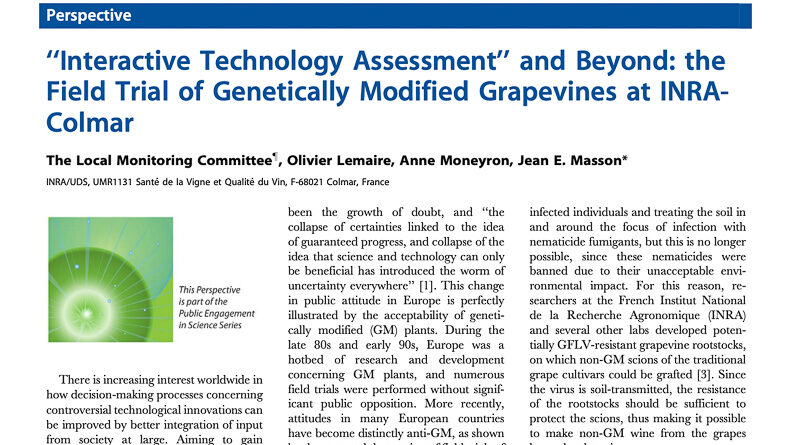The closest we’ve come to GM vines: the Colmar trials looking to defeat fanleaf virus
There are currently no genetically modified vines, but the closest we have come is transgenic rootstocks resistant to a major viral disease, that were successful in field trials in Alsace, but which were ripped out by activists. New research suggests that classical breeding might be another way to tackle this problem. Jamie Goode reports.
There aren’t any genetically modified vines being grown commercially. The technology is there, though: even though it’s technically quite hard to transform grapevines (that is, to introduce other genes into their genome), it has been done experimentally. The first grapevines were transformed in 1989, and the initial target was to take genes for resistance to downy and powdery mildew from American and Asian vines, and thus create versions of well-known varieties that hardly needed any spraying. This is something that conventional breeding can’t do, without creating new varieties.
But the closest we’ve come to commercial GM vines is with rootstocks that are resistant to the grapevine fan leaf virus (GFLV), which is a major problem in many regions. This virus is spready by the soil-dwelling dagger nematode Xiphinema index, and it causes crop loss, reduced quality, and reduces the life of the vine. The leaves of affected vines take on a fan-like appearance and then begin to turn a mottled yellow colour. In France this is known as court-noué disease, and it is recognized to be a big problem. In Champagne, an estimate from 2005 suggested that 2000 hectares were affected, which is 6% of vineyard area. In a recent survey of Champagne growers, they ranked court-noué as the second biggest problem they face in the vineyard, just behind powdery mildew and above downy mildew.
Attempts at breeding resistant rootstock were thwarted by the lack of innate resistance in wild or cultured grape varieties (although a report from 2021 shows that there is a promising candidate gene in Riesling – more on this later). And unlike leafroll virus, another hugely problematic virus that is spread by mealybug, it’s not possible to target the nematode vector of GFLV unless soil fumigation is used, which is environmental terrorism, and the nematacides that were previously used have been banned since 2003 in France.
So INRA, the French agricultural research body, worked with other institutions to produce two transgenic (genetically modified) rootstocks that introduced the CP gene from the virus into two rootstock genomes, 41B and SO4, making them resistant. They set up a trial in 1996 on a plot in Champagne. But the public attitude to GM crop plants changed and in 1999 local opposition caused this trial to be shut down.

But INRA decided to carry on and moved the trial to Alsace. This time, they did it in consultation with local growers, forming a Local Monitoring Committee which aimed to encourage dialogue and empower those who were initially suspicious. The only place they could run the trial was in INRA’s own vineyard in Colmar, but the issue here was that they didn’t have GFLV. So they had to bring in soil from an affected vineyard. And although the only genetically modified part of the vines in the trial was the roots, they tried to be sensitive to local anxieties, and so chose Pinot Meunier as the scion, which has a distinctive appearance and can easily be spotted. They also removed all the flowers, so no pollen was produced (even though this would not be genetically modified, this was done to ease the worries of those who didn’t trust the science). So of the 1588 plants in the trial, they eliminated all the flowers, even though only 70 were on GM rootstocks.
In a further step to make the trial ultra-safe, they laid a microporous geotextile membrane down before putting the soil in place, making sure that the nematodes couldn’t get out of the plot. The trial vineyard plot was planted in 2003.
Then, in 2009, a protester came along and sawed down the scions. But he left enough of the rootstocks so the trial could be reestablished. But in August 2010 a group of 65 protesters came back and uprooted the vines so that the trial couldn’t continue. This is the closest we have come to GM vines.
Since then the public attitude towards GM vines has made further research problematic. But in May 2021 a paper was published by Samia Djennane and colleagues in which they described finding resistance to GFLV in Riesling. They identified the source as a single recessive gene on chromosome 1, which they named as rgflv1. This is the first genetic resistance in Vitis species that has been described, and the authors were surprised that no one had noticed Riesling’s innate resistance to GFLV before. Because this resistance is monogenic – based on a single gene – it can be used in breeding programs, even though it is recessive.
Another line of research involves using vaccines, titled prémunition. The idea here is to expose vines to strains of GLFV that aren’t very aggressive, so that their defences are raised and when they meet an aggressive strain, it won’t infect them. The project is called Vaccivine, and the first stage is to use high-throughput screening to identify the strains of the virus that cause few symptoms. Then, using these, they will work out a protocol for infecting rootstock in order to vaccinate them.
The paper describing this GM rootstock trial is available here




